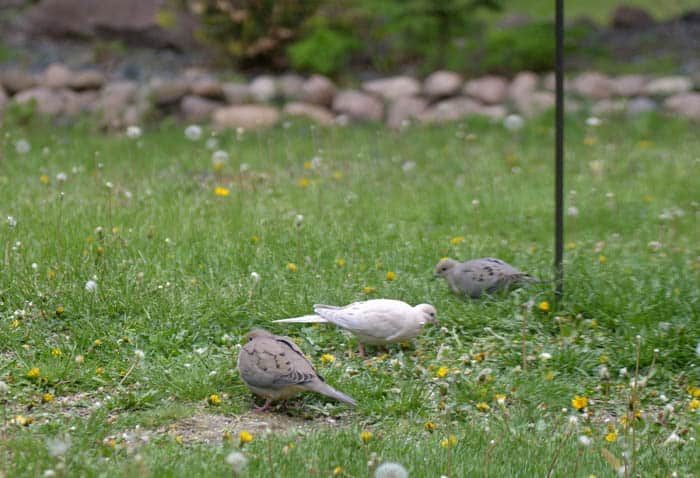Leucistic, Piebald, and Albino: What’s the Difference?
Patrick Durkin 07.22.15

At first glance my eyes tried telling me a small gull was scouring the grass below our birdfeeders, but I couldn’t imagine what a gull would find worth eating out there so I moved toward the window for a better look.
The grayish-white bird was pigeon-sized, but I’ve never seen a pigeon at our feeders either, so I kept examining the bird for recognizable features. Then I noticed its head was disproportionately small for its body. Suddenly everything made sense.
Our backyard bird was a leucistic mourning dove. That is, its plumage lacks melanin, making it look diluted or faded. It’s as if every feather in its body was washed in chlorine and hung too long in the sun to dry.

I had never heard of leucism until May 2013 when a leucistic junco hung out for a week or so before flying northward with the rest of its tribe. Unlike our all-white mourning dove, however, the leucistic junco was only white on its head and neck area, and had some color elsewhere. In other words, a piebald. I’ve seen piebald deer, so things were making more sense.
The unusual junco prompted me to photograph it and send the image to Ryan Brady, a bird-researcher with Wisconsin’s Department of Natural Resources. Brady informed me leucism isn’t rare, but it’s not exactly common, either. He also suggested I visit Cornell University’s “unusual birds” web page to read all that’s known about such birds.
For instance, leucism usually affects a bird’s dark feathers more than its light feathers. Leucistic birds can show some colors brightly, such as red, orange, or yellow. But feathers that should be brown or black are instead pale gray or white. Still other leucistic birds lose all the pigment in their feathers and appear pure white.
Leucism can also weaken the affected feathers. That’s because melanin is a key structural part of feathers. Birds with severe leucism have weaker feathers that wear out more swiftly than normal feathers. This makes flight more difficult, and eliminates some of the bird’s insulation against harsh weather.
White feathers also reflect heat more readily, which can kill birds that rely on sunbathing and solar radiation for heat in northern climates. White plumage also robs these birds of natural camouflage, making them easily seen by cats, foxes, hawks and other predators.
But that’ not the only disadvantage of being a leucistic bird. Plumage plays a vital role in courtship rituals, so researchers speculate that leucistic birds might have a tough time attracting strong, healthy mates.

And just so we’re clear, there’s no such thing as being “part albino.” Albinism affects all pigments, so albino birds have no color anywhere in their feathers, nor on their skin or eyes. Instead, they have reddish to pale pink eyes, legs, feet and bill. Leucistic birds often have pinkish legs and bill, as did our dove and junco, but other leucistic birds commonly have normal colors in their eyes, legs, feet and bills.
After spotting the white mourning dove, I retrieved my binoculars to verify the dove as leucistic, not albino. Its eyes were dark, not pink. Further, this was a full-sized mourning dove, and from what I’ve read, few if any albino birds reach adulthood. Their eyesight is poor, which by itself is a death sentence for any wildlife species.
We assume our leucistic mourning dove is just migrating through, and will move along after a few days. We have a flock of “regulars” that seem to live here year-round. They’re always hanging out around our feeders, perching on the thick power line to our house, or sunning on our gazebo’s south-facing roof on winter afternoons.
One such mourning dove spent much of late May perched on the gazebo’s rail within spitting distance of our kitchen window. Judging by its size and scaly looking plumage, I assumed it was the same fledgling we spotted a day earlier resting on our driveway.
That young dove let me get within three feet while I photographed it, but later in the afternoon it moved beneath the garage’s overhang. I assumed it had flown prematurely from its nest, and wouldn’t fly or walk unless it felt threatened. When I looked for it after dinner, it was gone. I hoped it flew into the nearby cedars for protection, and hadn’t fallen to one of our neighborhood’s roaming cats.
Again, I consulted Brady to see if there are other options for handling wayward fledglings. He advises people to leave them alone unless it’s certain they can’t fly. If that’s the case, find a small basket that self-drains, tie it a few feet up a leafy tree for protection from predators, and line it with some twigs and sticks to resemble a nest.

In a pinch, you could fashion your own nest from twigs, leaves, and other natural materials. Another option is to place it in a hanging flower pot. Mourning doves often use flower pots for their nests. Either way, a fledgling’s parents continue feeding stranded offspring.
If you’re clueless or helpless, consider contacting a wildlife rehabilitator, some of whom take in abandoned fledglings. Just realize you might have to drive some distance to reach them. Most rehabbers, however, deal only with small mammals or raptors.
Until transporting a bird or other injured/orphaned wildlife to a licensed rehabilitator, place it inside a ventilated container in a dark, warm, quiet place away pets, children, or other likely disturbances. Do not give it food or water, which can do more harm than good if the bird or animal isn’t in good condition.
Assuming that the fledgling in our driveway found its way to our gazebo rail, its chances for a long, normal life are probably better than the leucistic dove’s. Their looks might please our eye, but nature is indifferent to such traits.

